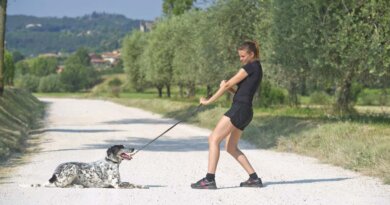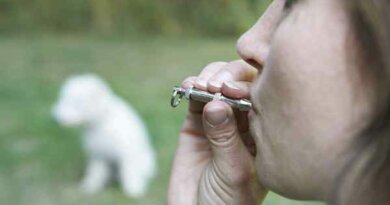The Ultimate Guide – Top Dog Tips
There is nothing wrong with a dog that wants to protect its loved ones, but it can lead to hurt when they act aggressively.
Possession aggression is frustrating, especially when your dog is three years old.
As difficult as it can be to teach your old dog new tricks, possession aggression is not impossible to stop! In no time, your lovely dog can smile and yip happily without attack.
What is possession aggression in dogs?
Not all dogs that show signs of possession suffer from possession aggression. It is usual for a dog to feel jealousy and want to be by your side.
However, if they become possessive and aggressively react to others, this can lead to difficult situations.
Neither you nor I want to be in a situation where their dog bites at another person or pet.
Possession aggression also has other common names, like food aggression or resource guarding. Sometimes the resources are food, their favorite toys, or their humans!
Signs of possession aggression
Before stopping your dog from reacting aggressively, you should know the signs before responding yourself.
The most common signs of possession aggression include:
- Snarling.
- Showing teeth to a stranger or other animal.
- Getting into an attack or defensive position.
Remember, dogs are fast! It takes only a few seconds for a dog to react aggressively.
If you think your dog is feeling stressed, the best thing you can do is take them out of the situation.
Other common signs of resource guarding are:
- snapping at other dogs
- refusing to play nicely
- not responding to commands
- fur standing up wildly
- standing with ears back and tail tucked in
It is important to note that even if your dog is wagging their tail or panting, this does not automatically mean they are happy.
Causes of possession aggression
So, what causes possession aggression?
How come some dogs aggressively react while others wag their tail in delight?
Most of the time, it boils down to how you train your dog.
If you do not fix poor behavior when your dog is a puppy, they will assume it is okay to react aggressively.
Their behavior includes hard bites or threatening growls.
However, every situation is different.
Some rescue dogs have had a hard life with not-so-nice owners.
When this happens, dogs learn to react aggressively to protect themselves and guarantee they have enough food and water.
It is a learned survival technique but not required in a loving and warm home.
Five ways to prevent possession aggression in dogs
After you notice the signs, it is your job to train your dog out of the bad habit.
However, it is easier to prevent posession aggression. Listed below are five unique ways to avoid possession aggression.
Distance Yourself
Firstly, when training your dog not to gain possessive, aggressive habits or reactions, it is crucial to distance yourself.
You must teach your dog that you won’t always be by their side.
It is hard at first, but necessary!
Walk away from your dog for at least 15 to 20 minutes a day and enter another room.
Don’t pay them any attention. It can hurt to hear your dog whine or cry, but they are okay!
Afterward, casually open the door or walk back into the room.
Don’t make a massive deal of it.
This way, they get used to being alone and not always by your side.
Encourage Individuality
Numbers 1 and 2 on this list are closely tied.
You want your dog to know you love them but not smother them to the point they feel nervous when they aren’t by your side.
Encourage them to play alone with toys. The best toys to use are puzzles or chew toys.
Every time year react pleasantly and play alone, give them a treat or prize.
Remember, not all rewards need to be edible treats. You can walk your dog longer, take them to a dog park, or give them a new toy.
Socialize Immediately After Adopting
One of the most important parts of owning a puppy or adopting an older dog is socializing them quickly.
It becomes much more challenging as they age and get used to their surroundings.
Instead, to prevent the development of posession aggression, you can help your dog get used to other animals.
This start with baby steps like taking your dog for walks.
During these walks, interactions with other humans or dogs are limited, which is excellent for first-time exposure.
As they get used to this, dog training classes and playdates can be next.
Always keep an eye on them no matter how comfortable or confident you are in your dog’s behavior!
Test Your Dog
We all want to trust and believe our dogs are the best and won’t ever mess up, but it does happen!
While training your dog to prevent posession aggression, you should also focus on testing them.
Do so in a comfortable and safe environment, though, where you can regain control of the situation.
One of the most significant possessions a dog reacts aggressively to is its food.
While getting used to the new training, get them comfortable with your hands and body near their food.
This also works with other possessive items like toys, beds, or treats.
If you have more than one dog, we recommend placing multiple bowls of food and water. This way, they grow comfortable sharing and being around others.
Eliminating the competition can make them feel a lot more comfortable, especially if they are shelter kennel dogs.
Slowly Introduce Your Dog to Others
Last but not least, a significant step to complete is slowly introducing your dog to others; this includes dogs and humans.
As tempting as opening the door and letting your dog greet your friends and family, dogs immediately think of new people as strangers.
You never know how your dog will react to new people, even if they are used to meeting people on walks or at dog parks.
Dogs feel incredibly territorial in their home and will try to protect you, even if it is unnecessary.
Keep your dog on a leash when introducing them to someone. Advise the person to walk slowly and calmly and let your dog smell them before taking them off the leash when confident.
FAQs on Aggression Possession in Dogs
Why is my dog suddenly possessive of me?
Typically, possessiveness happens over time.
However, if your dog is suddenly possessive of you, this could be a sign they are seeking attention.
Can dog aggression be corrected?
Dog aggression does not always last forever. You can correct it.
If it becomes too difficult, or you want a professional’s opinion, you can always speak to a canine behavior specialist.
How do I break my dog from resource guarding?
One of the best ways to break your dog from resource-guarding is to direct its attention to something else that is more interesting.
Use a command like ‘let go’ while also diverting their attention away. This is only a temporary solution, though.
What to do if your dog growls and snaps at you?
No one wants to be in a situation where their dog growls or snaps at them.
When this is the case, try and gain control over the situation as safely as possible.
But also, if you feel like you are in danger, take some steps back. When a dog barks, growls or makes loud noises, they are giving you a warning.
Aggression Possession in Dogs: Conclusion
Overall, managing canine possession aggression is frustrating and can be dangerous.
You don’t want your dog hurting anyone or themselves.
Possession aggression is a sign that your dog loves you and wants to be near you. Too much can cause a lot of tension and danger.
It is a lot easier to prevent these behaviors compared to correcting them later on.
Related







diflucan 150 mg cost https://diflucan.pro/ diflucan medicine in india